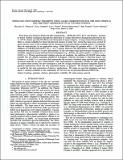Por favor, use este identificador para citar o enlazar a este item:
http://hdl.handle.net/10261/10792COMPARTIR / EXPORTAR:
 SHARE SHARE
 CORE
BASE CORE
BASE
|
|
| Visualizar otros formatos: MARC | Dublin Core | RDF | ORE | MODS | METS | DIDL | DATACITE | |

| Título: | Improving Photometric Redshifts using Galaxy Evolution Explorer Observations for the Sloan Digital Sky Survey Stripe 82 and the Next Generation of Otical and Sunyaev-Zeldovich Cluster Surveys |
Otros títulos: | Improving Photometric Redshifts using GALEX Observations for the SDSS Stripe 82 and the Next Generation of SZ Cluster Surveys | Autor: | Niemack, Michael D.; Jiménez, Raúl CSIC ORCID; Verde, Licia CSIC ORCID; Menanteau, Felipe; Panter, Ben; Spergel, David | Palabras clave: | Catalogues Cosmology: observations Galaxies: clusters: general Galaxies: distances and redshifts Galaxies: photometry Methods: data analysis |
Fecha de publicación: | 1-ene-2009 | Editor: | American Astronomical Society Institute of Physics Publishing |
Citación: | Astrophysical Journal 690(1): 89-101 (2009) | Resumen: | Four large-area Sunyaev-Zeldovich (SZ) experiments —APEX-SZ, South Pole Telescope, Atacama Cosmology Telescope, and Planck— promise to detect clusters of galaxies through the distortion of cosmic microwave background photons by hot (> 10^6 K) cluster gas (the SZ effect) over thousands of square degrees. A large observational follow-up effort to obtain redshifts for these SZ-detected clusters is under way. In addition, photometric optical surveys such as the Blanco Cosmology Survey, Dark Energy Survey, Panoramic Survey Telescope and Rapid Response System, and Large Synoptic Survey Telescope will detect and attempt to recover redshifts for billions of field galaxies in pursuit of a diverse array of science objectives. Given the large area covered by these surveys, most of the redshifts will be obtained via the photometric redshift (photo-z) technique. Here we demonstrate, in an application using ~3000 Sloan Digital Sky Survey stripe 82 galaxies with r < 20, how the addition of Galaxy Evolution Explorer (GALEX) photometry (F(UV), N(UV)) greatly improves the photometric redshifts of galaxies obtained with optical griz or ugriz photometry. In the case where large spectroscopic training sets are available, empirical neural-network-based techniques (e.g., ANNz) can yield a photo-z error of σz = 0.018(1 + z). If large spectroscopic training sets are not available, the addition of GALEX data makes the use of simple maximum-likelihood techniques possible, without resorting to Bayesian priors, and obtains σz = 0.04(1 + z), an accuracy that approaches that obtained using spectroscopic training of neural networks on ugriz observations. This improvement is especially notable for blue galaxies. To achieve these results, we have developed a new set of high-resolution spectral templates based on physical information about the star-formation history of galaxies. We envision these templates to be useful for the next generation of photo-z applications. We make our spectral templates and new photo-z catalogs available to the community at www.ice.csic.es/personal/jimenez/PHOTOZ. | Descripción: | 13 pages, 8 figures.-- Online version published on Dec 1, 2008.-- ArXiv pre-print available at: http://arxiv.org/abs/0803.3221 | Versión del editor: | http://dx.doi.org/10.1088/0004-637X/690/1/89 | URI: | http://hdl.handle.net/10261/10792 | DOI: | 10.1088/0004-637X/690/1/89 | ISSN: | 0004-637X |
| Aparece en las colecciones: | (ICE) Artículos |
Ficheros en este ítem:
| Fichero | Descripción | Tamaño | Formato | |
|---|---|---|---|---|
| 0803.3221v1.pdf | 788,68 kB | Adobe PDF |  Visualizar/Abrir |
CORE Recommender
SCOPUSTM
Citations
14
checked on 08-may-2024
WEB OF SCIENCETM
Citations
13
checked on 24-feb-2024
Page view(s)
380
checked on 09-may-2024
Download(s)
246
checked on 09-may-2024
Google ScholarTM
Check
Altmetric
Altmetric
NOTA: Los ítems de Digital.CSIC están protegidos por copyright, con todos los derechos reservados, a menos que se indique lo contrario.
